It's always been a hassle for us Sabahans to get a Chinese visa because the Chinese embassy maintains only two branches in the country, one in KL and one in Kuching. The runners make their trips on Tuesdays and Fridays and if your schedule doesn't fit, you need to fly to those cities yourself. And that was what Yi and I did yesterday. We flew into Kuching in the morning and left the same night.
I've been to Kuching once, more than 10 years ago and I can't remember much of it. I hear that Kuching has some of the best food in Malaysia, after Penang. Some would say Malacca too but I wasn't impressed on my previous trip there so Malacca's not on my food wish list.
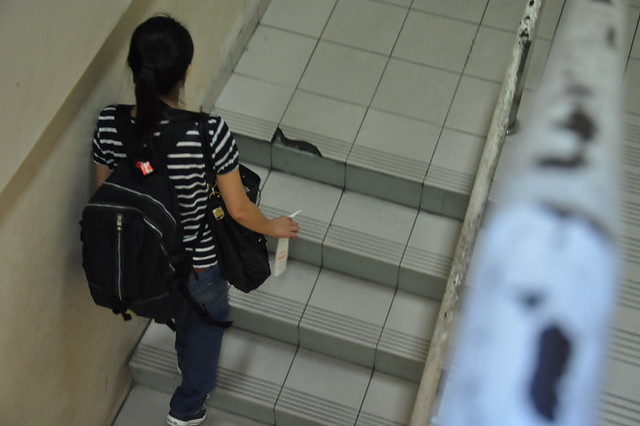
My first impression of Kuching's airport was that it was better than the budget Terminal Two in KK but Yi informed me that Kuching has only one airport. Strike One KK, because we have a Terminal One and it's an in-ter-na-tion-al airport. On the way into the airport, I was walking up the steps when I suddenly bumped my head against a ledge overhead. Yi re-enacted the spot in the photo above. If the steps are crowded and you are taller than 5 feet, you will get a nasty bump. While I was rubbing the bump on my head, another lady hit her head too and it wasn't funny because I could see she was in pain.
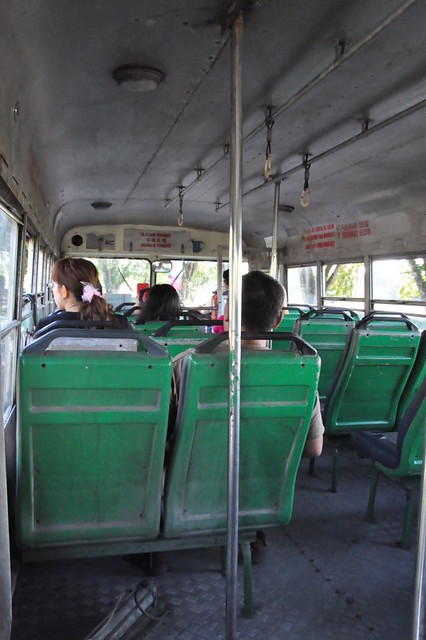
After submitting the forms at the Chinese embassy, we found ourselves in the middle of no where, with no taxis. A vehicle that looked like a bus came along. We got on excitedly since it's been ages since we've been in a bus in Malaysia. In my excitement, I didn'! t take a photo of the bus, a relic kind of vehicle which was last seen in KK (Strike 2) in the 1970s. Here's a photo taken inside the bus. I think that's how it must be like in Cambodia.
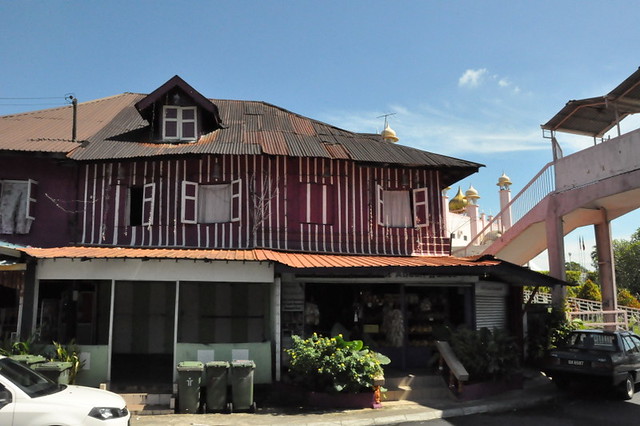
My impression of Kuching from the bus (fare was RM2/USD 70 cents per person; inflation has caught Kuching up) was that it is very big and widely spread out. There's no proper zoning and the city and residential areas are all merged so that there's no distinct city center. I'm not sure where the CBD is, or if there's any (not that we have much of a CBD in KK) and all the buildings were low rise, the tallest being about 10 storeys.
Old buildings such as the one in the photo above are still standing and they give a nostalgic air to the city (is Kuching a city?). Kuching reminds me of KK in the old days when I was growing up. I think what I like most about Kuching is the large expense of greenery here and there although I think that whoever cut those dozens of big trees along the road from the airport should be jailed, if not executed.
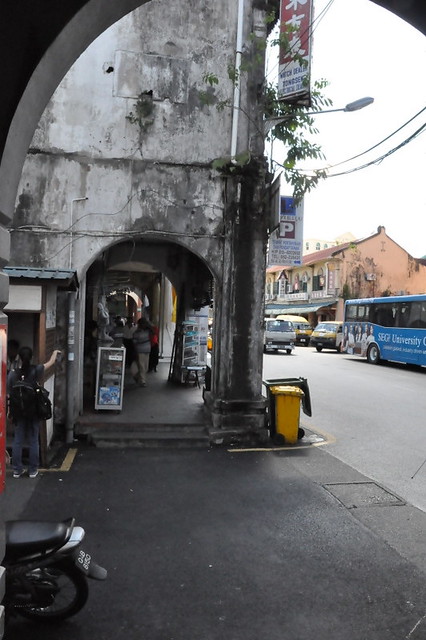
This looks like some parts of Penang.
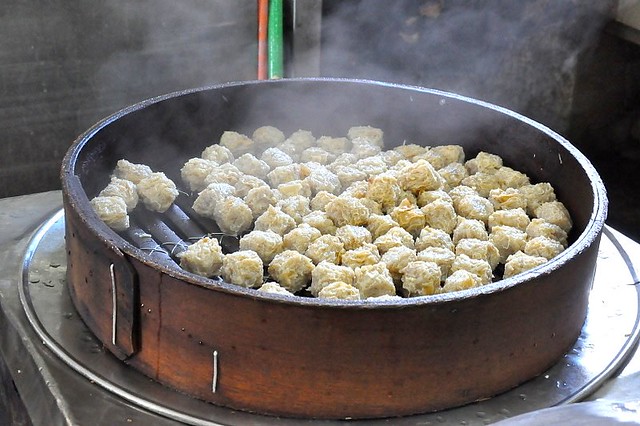
Yi bought some shiou beefrom a food market. Shiou beeare like siew mai but not as tasty. I couldn't tell what meat was in them, but there were bits of crunchy stuff which I think were jicama (bangkuang). Yi thinks that shiou bee are the precursors of ! the Auss sie dim sims, those awful giant meatballs you find in fish and chips places.
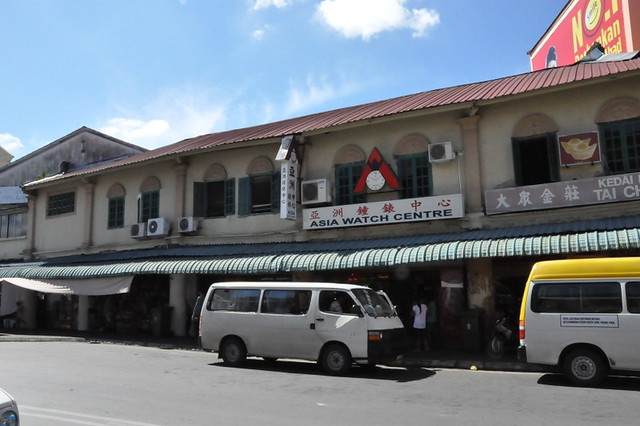
Kuching's got character. Unlike Malacca or Singapore where old shoplots with wooden shutters have been perfectly copied or touched up, the ones on Kuching are authentically old and the 1st storeys of the shoplots are still occupied by the shopowners.

They even have columns with carvings, so European. KK has demolished all the old buildings and the city, like most modern cities in Asia, is characterless and uninteresting.
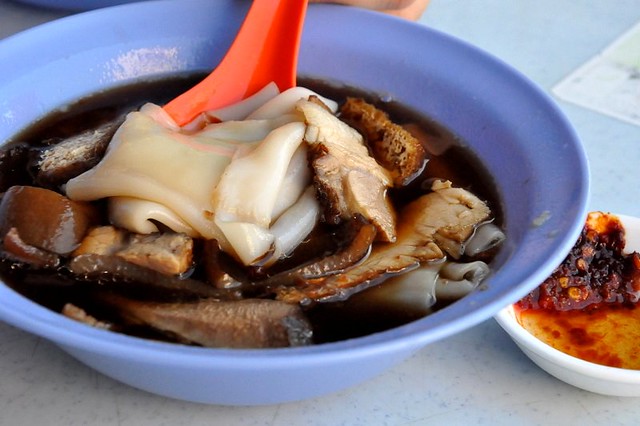
Yi loves kuey chap, a noodle dish we don't get in KK. Kuey chap noodles are small broad pieces of rice noodles in a slightly herbal soup with pieces of pig innards. I was told by a shop keeper later that the best kuey chap is in Johor Bahru and it's called kuey chap gia(kuey chap kid) because the noodles are thin, not broad.
Straight from the kuey chap stall on Jalan Ang Cheng Ho, we went to Min Joo, THE place for Kuching kolo mee.Kuchingkolo mee(white dry-tossed noodles) is the city's second most famous dish, after Kuchinglaksa.
Min Joo was crowded and we have heard that it takes an hour to be served. We couldn't spare an hour because we wanted to get to Choon Hui Cafe, about 15 minutes by taxi, for Kuching's best Kuchinglaksa.

RM4/USD1.30 per bowl. You can choose to have the toppings on the noodles or in soup.
Leaving Min Joo, we went a few steps away to Kim Joo, the copycat. There were lots of seats and we were served immediately. I found the kolo mee in Kim Joo just okay, a7/10,not something I'll crave for mainly because I can get the same thing, more or less, in KK.
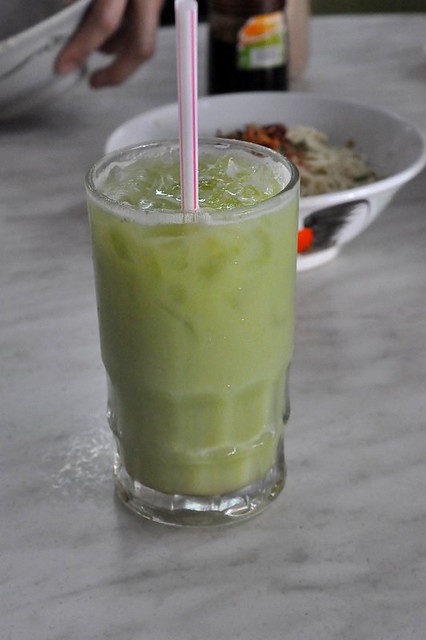
But this I like, the iced kedongdong juice. Kedongdong is a sour fruit with a nice fragrance and is related to the starfruit. In the muggy heat, this drink was a life saver. I don't sweat easily but at this point, my sweat were dripping and rolling down my back and face. Yi and I wished we could take the earlier flight home.

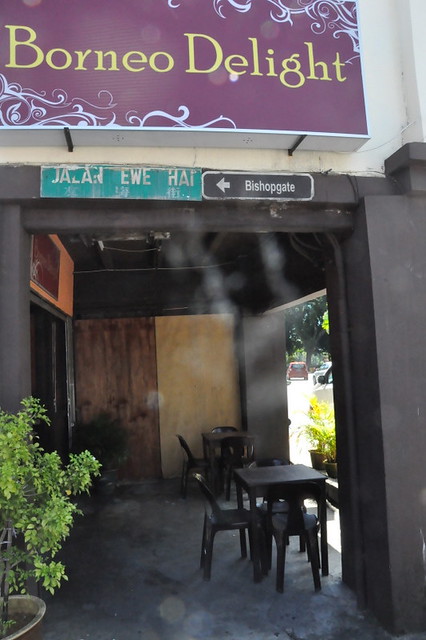
How rustic is that. We don't get such places in KK anymore.

Astragically-placed trishawin a street for tourists.
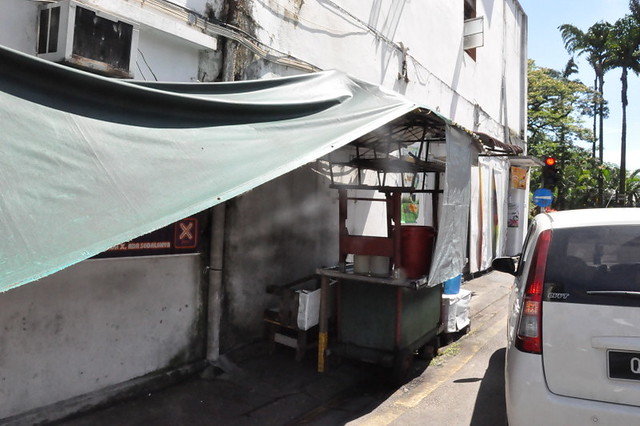
This stall by the side of a road serves the best iced cendol in Kuching. I was relieved it wasn't open.
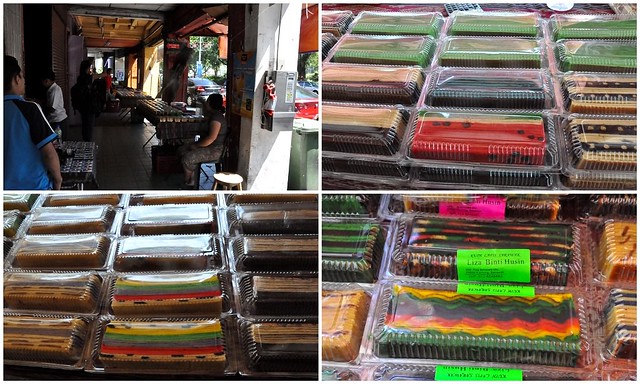
We turned the corner from Bishopgate and found an interesting street where people were selling colorful (but yukky) lapis (layered) cake. There are many souvenir shops too but they banned photo-taking even from the outside so too bad for them because I won't be giving them free ad space here. There are also some shops that sell local hardwood furniture which are absolutely gorgeous.
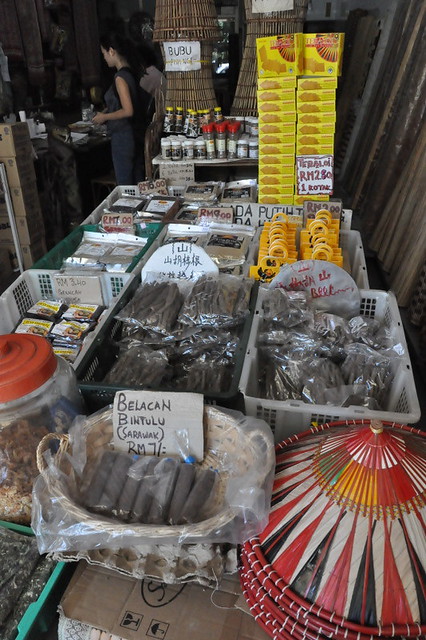
Sarawak is the leading pepper supplier in the world and besides the peppercorns, this shop sells pepper roots (for soup) and pepper candies. No pepper spray.
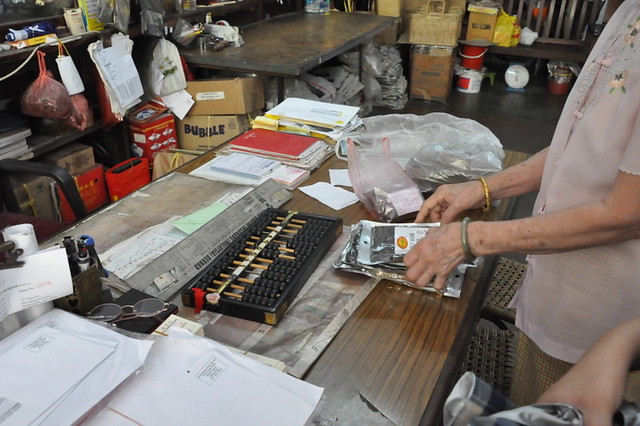
The shop keeper was an elegant lady, still very pretty although she was 82. Yi and I were inspired. She used a Chinese abacus to total up our purchase and gave me a calculater and yes, she was faster than me.
I've been to Kuching once, more than 10 years ago and I can't remember much of it. I hear that Kuching has some of the best food in Malaysia, after Penang. Some would say Malacca too but I wasn't impressed on my previous trip there so Malacca's not on my food wish list.

My first impression of Kuching's airport was that it was better than the budget Terminal Two in KK but Yi informed me that Kuching has only one airport. Strike One KK, because we have a Terminal One and it's an in-ter-na-tion-al airport. On the way into the airport, I was walking up the steps when I suddenly bumped my head against a ledge overhead. Yi re-enacted the spot in the photo above. If the steps are crowded and you are taller than 5 feet, you will get a nasty bump. While I was rubbing the bump on my head, another lady hit her head too and it wasn't funny because I could see she was in pain.

After submitting the forms at the Chinese embassy, we found ourselves in the middle of no where, with no taxis. A vehicle that looked like a bus came along. We got on excitedly since it's been ages since we've been in a bus in Malaysia. In my excitement, I didn'! t take a photo of the bus, a relic kind of vehicle which was last seen in KK (Strike 2) in the 1970s. Here's a photo taken inside the bus. I think that's how it must be like in Cambodia.

My impression of Kuching from the bus (fare was RM2/USD 70 cents per person; inflation has caught Kuching up) was that it is very big and widely spread out. There's no proper zoning and the city and residential areas are all merged so that there's no distinct city center. I'm not sure where the CBD is, or if there's any (not that we have much of a CBD in KK) and all the buildings were low rise, the tallest being about 10 storeys.
Old buildings such as the one in the photo above are still standing and they give a nostalgic air to the city (is Kuching a city?). Kuching reminds me of KK in the old days when I was growing up. I think what I like most about Kuching is the large expense of greenery here and there although I think that whoever cut those dozens of big trees along the road from the airport should be jailed, if not executed.

This looks like some parts of Penang.

Yi bought some shiou beefrom a food market. Shiou beeare like siew mai but not as tasty. I couldn't tell what meat was in them, but there were bits of crunchy stuff which I think were jicama (bangkuang). Yi thinks that shiou bee are the precursors of ! the Auss sie dim sims, those awful giant meatballs you find in fish and chips places.

Kuching's got character. Unlike Malacca or Singapore where old shoplots with wooden shutters have been perfectly copied or touched up, the ones on Kuching are authentically old and the 1st storeys of the shoplots are still occupied by the shopowners.

They even have columns with carvings, so European. KK has demolished all the old buildings and the city, like most modern cities in Asia, is characterless and uninteresting.

Yi loves kuey chap, a noodle dish we don't get in KK. Kuey chap noodles are small broad pieces of rice noodles in a slightly herbal soup with pieces of pig innards. I was told by a shop keeper later that the best kuey chap is in Johor Bahru and it's called kuey chap gia(kuey chap kid) because the noodles are thin, not broad.
Straight from the kuey chap stall on Jalan Ang Cheng Ho, we went to Min Joo, THE place for Kuching kolo mee.Kuchingkolo mee(white dry-tossed noodles) is the city's second most famous dish, after Kuchinglaksa.
Min Joo was crowded and we have heard that it takes an hour to be served. We couldn't spare an hour because we wanted to get to Choon Hui Cafe, about 15 minutes by taxi, for Kuching's best Kuchinglaksa.

RM4/USD1.30 per bowl. You can choose to have the toppings on the noodles or in soup.
Leaving Min Joo, we went a few steps away to Kim Joo, the copycat. There were lots of seats and we were served immediately. I found the kolo mee in Kim Joo just okay, a7/10,not something I'll crave for mainly because I can get the same thing, more or less, in KK.

But this I like, the iced kedongdong juice. Kedongdong is a sour fruit with a nice fragrance and is related to the starfruit. In the muggy heat, this drink was a life saver. I don't sweat easily but at this point, my sweat were dripping and rolling down my back and face. Yi and I wished we could take the earlier flight home.


How rustic is that. We don't get such places in KK anymore.

Astragically-placed trishawin a street for tourists.

This stall by the side of a road serves the best iced cendol in Kuching. I was relieved it wasn't open.

We turned the corner from Bishopgate and found an interesting street where people were selling colorful (but yukky) lapis (layered) cake. There are many souvenir shops too but they banned photo-taking even from the outside so too bad for them because I won't be giving them free ad space here. There are also some shops that sell local hardwood furniture which are absolutely gorgeous.

Sarawak is the leading pepper supplier in the world and besides the peppercorns, this shop sells pepper roots (for soup) and pepper candies. No pepper spray.

The shop keeper was an elegant lady, still very pretty although she was 82. Yi and I were inspired. She used a Chinese abacus to total up our purchase and gave me a calculater and yes, she was faster than me.
No comments:
Post a Comment